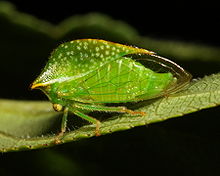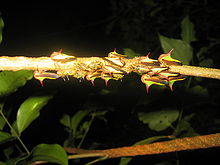- Treehopper
-
Treehopper Ceresa taurina Scientific classification Kingdom: Animalia Phylum: Arthropoda Class: Insecta Order: Hemiptera Suborder: Auchenorrhyncha Infraorder: Cicadomorpha Superfamily: Membracoidea Family: Membracidae Subfamilies Centronodinae (disputed)
Centrotinae
Darninae
Endoiastinae
Heteronotinae
Membracinae
Nicomiinae (disputed)
Smiliinae
Stegaspidinae (disputed)
and see textSynonyms Nicomiidae
Treehoppers (more precisely typical treehoppers to distinguish them from the Aetalionidae) and thorn bugs are members of the family Membracidae, a group of insects related to the cicadas and the leafhoppers. There are about 3,200 known species of treehoppers in over 600 genera. They are found on all continents except Antarctica, although there are only three species in Europe.
They are best known for their enlarged and ornate pronotum, which most often resembles thorns, apparently to aid camouflage. But in some species, the pronotum grows to a horn-like extension, and even more bizarre and hard-to-describe shapes are also found.
Thorn bugs, due to their unusual appearance, have long interested naturalists. There is no way to tell the male and females apart other than looking at the male genitalia. Individual treehoppers usually live for only a few months, but they belong to a lineage that is at least 40 million years old.
A team from the Institute of Developmental Biology of Marseille-Luminy in 2011 provide good evidence that the specialised pronotum (or helmet) is not simply an expansion of the prothoracic sclerite, but a fused pair of dorsal appendages of the first thoracic segment, serial homologues of insect wings, which are dorsal appendages of the second and/or third thoracic segments. (anatomical evidence: The helmet arises as a pair of appendages, attached to each side of the dorsal prothorax by an articulation, with muscles and flexible membrane that allow it to be mobile. Genetic evidence: the same genes are involved in development of the helmet and wings.[1]
Contents
Ecology
Treehoppers pierce plant stems with their beaks, and feed upon sap. The immatures can frequently be found on herbaceous shrubs and grasses, whereas the adults more often frequent hardwood tree species. Excess sap becomes concentrated as honeydew, which often attracts ants. Some species have a well-developed ant mutualism, and these species are normally gregarious as well, which attracts more ants. The ants provide protection from predators.
Others have formed mutualisms with wasps, such as Parachartergus apicalis.[2] Even geckos form mutualistic relations with treehoppers, with whom they communicate by small vibrations of the abdomen.[3]
Eggs are laid by the female with her saw-like ovipositor in slits cut into the cambium or live tissue of stems, though some species lay eggs on top of leaves or stems. The eggs may be parasitised by wasps, such as the tiny fairyflies (Mymaridae) and Trichogrammatidae. The females of some membracid species sit over their eggs to protect them from predators and parasites, and may buzz their wings at the intruder. The females of some gregarious species work together to protect each others' eggs. In at least one species, Publilia modesta, mothers serve to attract ants when nymphs are too small to produce much honeydew. Some other species make feeding slits for the nymphs.[4]
Like the adults, the nymphs also feed upon sap, and unlike adults, have an extensible anal tube that appears designed to deposit honeydew away from their body. The tube appears to be longer in solitary species that are rarely ant attended. It is important for sap-feeding bugs to dispose of honeydew, as otherwise it can become infected with sooty moulds. Indeed, there is evidence that one of the benefits of ants for individuals of the species Publilia concava is the ants remove the honeydew and reduce such growth.
Most species are innocuous to humans, although a few are considered minor pests, such as Umbonia crassicornis (a thorn bug), the three-cornered alfalfa hopper (Spissistilus festinus), or the buffalo treehopper (Stictocephala bisonia), which has been introduced to Europe. Cowbug(Oxyrachis tarandus)is resently recorded as a pest of Withania somnifera plant [5] , from India.
Systematics
The diversity of treehoppers has been rather little researched, and their systematic arrangement is tentative. It seems that three main lineages can be distinguished; the Endoiastinae are the most ancient treehoppers, still somewhat resembling cicadas. Centrotinae form the second group; they are somewhat more advanced but the pronotum still does not cover the scutellum in almost all of these. The Darninae, Heteronotinae, Membracinae and Smiliinae contain the most apomorphic treehoppers.
Several proposed subfamilies seem to be paraphyletic. Centronodinae and Nicomiinae might need to be merged into the Centrotinae to result in a monophyletic group. And while most the Stegaspidinae also appears to belong there, united by genera like Smerdalea and Smergotomia, members of the "Stegaspidinae" in fact appear to be distributed all across the treehoppers, and the taxon is probably best abolished altogether.
References
- ^ Benjamin Prud'homme et coll (5 may 2011). "Body plan innovation in treehoppers through the evolution of an extra wing-like appendage" (in en). Nature 473 (7345): 83–86. doi:10.1038/nature09977.
- ^ Wetterer (2000). "Diel Shifts in Treehopper-Tending by Ants and Wasps in Costa Rica (Hymenoptera)" (PDF). Sociobiology 36: 1. http://www.nceas.ucsb.edu/~aukema/Wettereretal2000.pdf.
- ^ BBC documentary Life in Cold Blood, episode Dragons of the Dry, minute 22
- ^ Chung-Ping Lin, Bryan N. Danforth & Thomas K Wood (2004). "Molecular phylogenetics and evolution of maternal care in membracine treehoppers" (PDF). Systematic Biology 53 (3): 400–421. doi:10.1080/10635150490445869. PMID 15503670. http://web.thu.edu.tw/treehops/www/download/Lin%20et%20al.%202004.pdf.
- ^ Sharma A, Pati PK (2011). "First report of Withania somnifera (L.) Dunal, as a New Host of Cowbug (Oxyrachis tarandus, Fab.) In Plains of Punjab, Northern India" (pdf). World Applied Sciences Journal 14 (9): 1344-1346. ISSN 1818-4952. http://idosi.org/wasj/wasj14%289%2911/13.pdf.
- C. Godoy, X. Miranda, K. Nishida:: Membrácidos de la América Tropical / Treehoppers of Tropical America. Santo Domingo de Heredia: INBIO, Inst. Nacional de Biodiversidad, 2006, ISBN 9968-927-10-4
External links
- Treehopper FAQ
- BugGuide Photos of North American species
- West Virginia Membracidae
- University of Florida entomology
- DrMetcalf: a resource on cicadas, leafhoppers, planthoppers, spittlebugs, and treehoppers
- Treehoppers: Aetalionidae, Melizoderidae, and Membracidae (Hemiptera)
- Aliens of the Amazon documentary
Categories:- Auchenorrhyncha
- Insect vectors of plant pathogens
Wikimedia Foundation. 2010.


